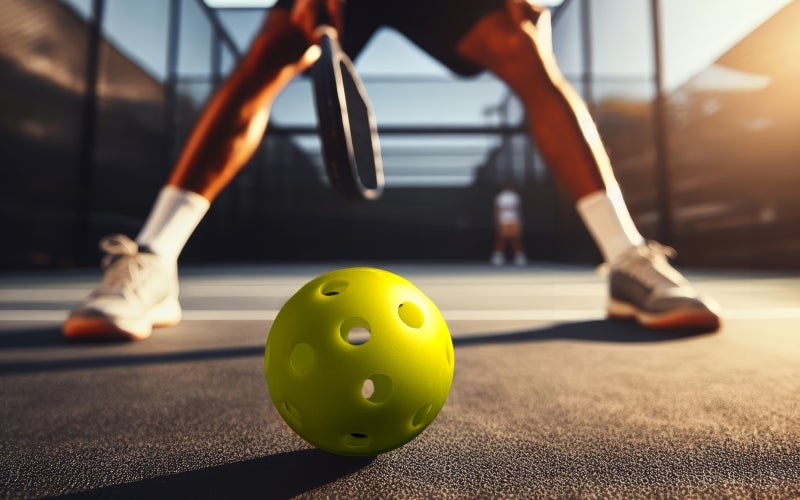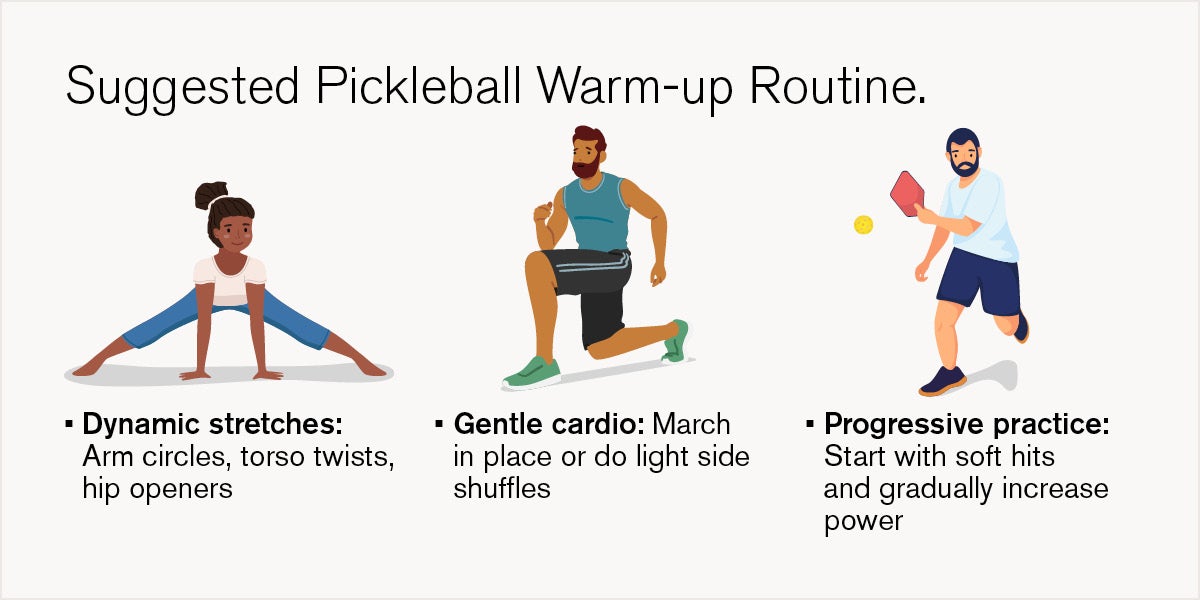Your Guide to Pickleball Safety for Every Age and Skill Level
June 11, 2025
Categories: Sports Medicine, Orthopaedics
By Nickolas G. Garbis, MD, Orthopedic Surgery
Pickleball has taken the country by storm with no signs of slowing down anytime soon. Known for being fun, social, and easy to learn, pickleball has become popular among people of all ages looking to stay active. But as with any sport, safety matters.
In fact, recent data shows that pickleball-related injuries are increasing (particularly for players over the age of 55), and sprains, strains, and falls are common. The good news is that most of these are preventable.
Whether you’re a new player, returning to the court after years away, or looking to stay active, here’s how to play it safe while enjoying the game.
Choose the right pickleball equipment
1. Supportive footwear
Start from the ground up. Running shoes may be great for walking, but they’re not ideal for pickleball. Instead, look for court shoes with strong lateral support. These are designed for side-to-side movement and help prevent ankle injuries, which are especially common among older adults.
2. Appropriate paddle weight
A paddle that’s too heavy can strain the wrist, elbow, and shoulder. Lightweight paddles reduce fatigue and are easier on joints. Players with arthritis or a history of tendinitis may benefit from paddles with vibration dampening materials. These paddles are made of graphite or carbon fiber face materials, or gel-core technology. You can also use certain tape or grips to reduce the vibrations.
3. Optional (but smart) eye protection
In doubles play, there’s an increased risk of taking a paddle or ball to the face. Protective eyewear is a simple addition that can prevent serious injury. This is especially important for seniors who may bruise or swell more easily.
“People are often surprised how much strain a poorly chosen paddle or shoe can put on your joints. Using the right gear isn’t just about performance; it’s your first line of defense against injury,” says Nickolas Garbis, MD, orthopaedic surgeon at Loyola Medicine.
Warm up to avoid pickleball injuries
Many injuries happen within the first few minutes of a game when the muscles aren't properly ready for play. Taking 5 to 10 minutes to warm up increases circulation, lubricates joints, and preps the body for sudden movements, all key to preventing strains and sprains.

“A few minutes of warm-up can mean the difference between a great game and weeks of recovery. It’s one of the simplest ways to stay safe and keep doing what you love,” says Dr. Garbis. This is especially important for older adults, whose muscles and joints may take longer to loosen up.
Stay hydrated and weather-wise on the court
Pickleball is often played outdoors where dehydration is a real concern, particularly for seniors who may be more sensitive to heat.

Older adults and those with chronic health conditions are at greater risk of heat-related illness. If you begin to feel lightheaded or nauseous, stop immediately, rest in a shaded area, and rehydrate. If symptoms do not improve or worsen, call 911 as they may be suffering from heat exhaustion.
Build a safe foundation to prevent game-day falls and injuries
If there’s one thing all pickleball players can agree on, it’s that the best way to stay in the game is to avoid preventable injuries. Falls are one of the most common causes of serious injury, but they’re often avoidable with the right habits both on and off the court.
Keep the court and your movements clear
Simple adjustments can make a big difference in preventing falls during play:
- Clear the playing area of stray balls, water bottles, and towels to avoid tripping.
- Wipe your shoes before entering the court to remove dust or moisture.
- Avoid backpedaling. Instead, pivot or turn to safely track a ball behind you.
- Be aware of your surroundings, including fencing, net posts, and other players.
Improve strength and balance off the court
Your safety during play often depends on how you prepare off the court. “Most falls occur because of poor balance, weak muscles, or hesitation. Conditioning off the court is just as important as how you move on it,” says Dr. Garbis. Working on strength, flexibility, and balance can significantly lower the risk of injury.
- Practice balance exercises at home, such as single-leg stands or heel-to-toe walking.
- Incorporate low-impact strength training to support muscles and joints.
- Stretch regularly to reduce stiffness, improve range of motion, and support coordination.
- Stay active between games. Walking, swimming, or yoga can keep you limber and conditioned.
If you’ve had a fall in the past, are new to physical activity, or have underlying health conditions such as osteoporosis or joint replacements, speak with your physician or a physical therapist before taking a swing at pickleball. They can help you build a personalized routine to prepare your body and reduce your risk.
Bounce back with smart pickleball recovery tips
After a great game, it’s normal to feel sore, but it shouldn’t be painful. And for older players, recovery may take a bit longer than it used to.
If you experience discomfort:
- Apply ice to sore areas within the first 24 hours.
- Use compression and elevation for swelling.
- Take anti-inflammatory medication if needed (after checking with your doctor).
- Rest when needed. Don’t rush back onto the court if you're not fully healed.
If pain persists beyond a couple of days or if you can't bear weight on a joint, it's time to see a medical professional.
“If pain is changing the way you move or making you hesitate, that’s your body asking for rest. Recovery isn’t a setback, but rather part of staying active long-term,” says Dr. Garbis.
Don’t skip your health check-up
Before starting any new sport, it’s wise to schedule a routine physical, especially for adults over age 50. This helps identify any underlying conditions (like heart or joint issues) that may be present, and ensures your body is ready for regular activity.
The bottom line? Playing pickleball safely means more than just avoiding slips and trips. It’s about building habits that support your physical health, confidence, and consistency over time. With the right foundation, you can stay on the court longer and enjoy the game more.
Nickolas Garbis, MD, is a board-certified orthopaedic surgeon at Loyola University Medical Center, specializing in shoulder and elbow surgery. Recognized for his expertise, he is a member of the American Shoulder and Elbow Surgeons, a prestigious organization comprising of only a few physicians nationwide. He also participates in clinical research, contributing to advancements in shoulder arthroplasty techniques.
